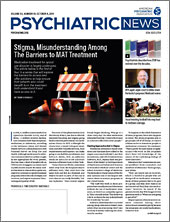Jenny Boyer, M.D., J.D., Ph.D., covers a lot of ground as a full-time telepsychiatrist, working from her home for the Department of Veterans Affairs.
Her geographic area of clinical responsibility in West Texas includes Big Springs, Abilene, San Angelo, and Odessa. She has also connected with patients in Hobbs, N.M.
Last month her reach across the rural regions of the Southwest United States brought her into contact with survivors of, and witnesses to, the mass shooting in Odessa in August, in which eight people were killed and 25 injured.
A significant number of her more than 500 regular telepsychiatry patients are veterans who have seen combat, and they had a unique perspective on that event and a response shaped by their own historical experience. The shooting spree began after a routine traffic stop in which the perpetrator fired at police officers, then drove through the Odessa and Midland areas of Texas shooting randomly. It ended when police killed the gunman outside a movie theater.
Describing her experience with patients in Odessa after the shooting—and more generally as a full-time telepsychiatrist—Boyer emphasized that she was speaking on her own behalf and not for the Department of Veterans Affairs (VA).
“A couple of my patients reported that during the shooting, they were in combat mode, calling on their training to protect civilians and to face an enemy,” said Boyer, who is also APA’s Area 5 trustee. “The shooting was very loud, lasting a couple of hours, and the shooter was moving, which is like combat. They saw an active-duty colleague killed, and it caused them to relive their own combat experiences.
“Their training made them fearless, not thinking of themselves until it was all over,” Boyer told Psychiatric News. “But afterward, many were unable to sleep and avoided talking to anyone. They were waiting at the door [of the telepsychiatry clinic where they receive care] to try to see me the first day I was on duty after the shooting. These veterans were stalwart, then tearful, and afraid that our country is becoming a combat zone.”
The delayed traumatic response to a shooting is familiar to other psychiatrists who have treated survivors. “We psychiatrists are second-line responders in a disaster such as this, waiting for these symptoms to percolate over time,” psychiatrist Lesley Dickson, M.D., executive director and a past president of the Nevada Psychiatric Association, told Psychiatric News after the shooting at the Route 91 Harvest Country Music festival two years ago in Las Vegas. “We can expect these people to show up weeks or even months after the event with a story to tell, one they need to tell.”
A Long Reach
Boyer’s patients in Odessa and elsewhere throughout “Texoma” can thank the VA’s commitment to telemedicine and telepsychiatry. According to the VA, in Fiscal 2018 the Veterans Health Administration provided more than 2.29 million episodes of telehealth care to more than 782,000 patients; more than 45% of these veterans live in rural areas.
The VA has three programs that draw on information and telecommunications technology:
•
Synchronous telehealth is the use of real-time, interactive videoconferencing, sometimes with supportive peripheral technologies, to assess and provide care to a patient remotely. Typically, the patient at a clinic is linked to a health care professional at another location.
•
Asynchronous telehealth is generally defined as the use of technologies to acquire and store clinical information (for example, data, image, and sound), which is then forwarded to or retrieved by a health care professional at another location for clinical evaluation.
•
Remote patient monitoring is a program in which veterans with chronic conditions (for example, hypertension or diabetes) can opt to enroll in. The program applies care and case management principles to coordinate care through health informatics, disease management, and technologies such as in-home mobile monitoring, messaging, and video.
The VA’s TeleMental Health program conducted about 473,000 consultations with more than 151,600 veterans in 2017. Services provided via the program reduced acute psychiatric VA bed days of care by 40% and VA hospital admissions by 34%, according to the VA.
Boyer works from her home in Norman, Okla., seeing patients in real time; her day begins at 6 a.m. when she makes sure she can connect to whichever clinic she is scheduled to see patients first.
The majority of her patients have major depression, bipolar disorder, sleep apnea, and/or substance use disorders. But many of her patients are also general medical patients with diabetes and orthopedic problems.
Boyer sees younger patients who have traumatic brain injury and older veterans of Vietnam and Korea. As a woman, she is frequently in demand by women veterans.
“The pros of telehealth are that it really helps patients with a lot of complications save the time and trouble and travel of having to go to a big city center,” Boyer said. “It helps to be able to not have to drive to Dallas or Houston if you live hundreds of miles away. Sometimes patients may not like [telepsychiatry] at first, but when they see that it works, they come around.”
Boyer has a passion for public service psychiatry, and she said that the technology and distance involved in telehealth do not impede the forging of a relationship with her patients.
The strength of the relationships that Boyer has forged with her telepsychiatry patients was especially important to the veterans of Odessa, even those who were not witness to or directly affected by the shooting. “I had patients who could not make themselves come in [to the clinic], but I was able to call them after hours,” Boyer said. “Some of these patients would not leave the house and wanted to avoid any kind of crowds. Others refused to watch the news and avoided anyone who wanted to talk about the shooting, trying to fight off the effect it had had on them.”
Boyer added, “My own heart is sad, but so proud of these good people. ■

